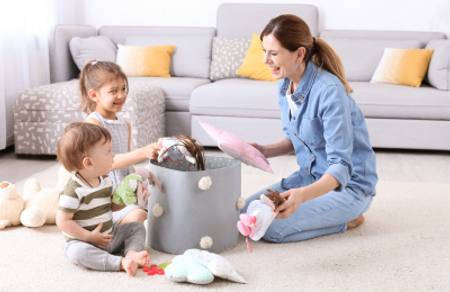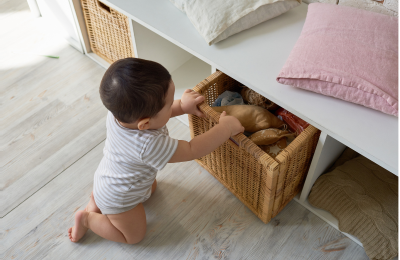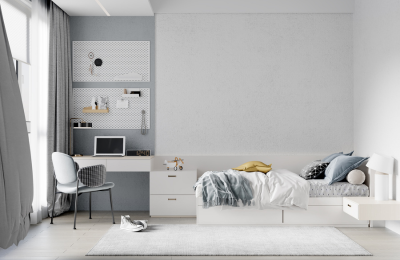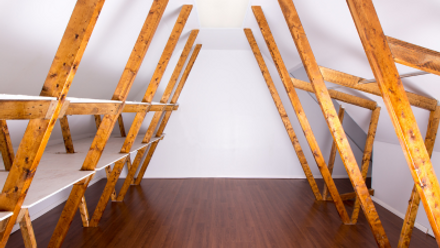Back to basics - Kids' spaces
5 minute read
Organising, decluttering, tidying and maintaining kids' spaces is a frequent challenge that comes up in our line of work. Many parents, whether managing spaces with toddlers and newborns or navigating the chaos of teenagers, find it exhausting to keep things in order. From kitchen tables buried under schoolwork, toys and shoes to despairing parents drowning in piles of dirty laundry, the struggle is real. Without effective systems in place that ensure everyone contributes, tensions rise, tasks spiral out of control and the situation can quickly become overwhelming.
APDO member Sophie Mew shares her thoughts on assessing the kid's spaces in your home and suggests simple, practical tips that have helped her clients as well as strategies she's implemented in her own home for her two children (ages 9 and 6).
What Are the Best Systems for Organising Kids' Spaces?
When we talk about "kids' spaces” it could refer to a shared siblings’ bedroom, a dedicated playroom, or even a corner of the living room. Who owns the space, and how it’s used, varies from family to family. I always say to my clients that our homes, lifestyles and amount of time we have are unique to each of us. There are no ‘one size fits all’.

Organising With or Without Kids: A Debate
Deciding whether to organise with or without the kids is a hot topic. It’s undoubtedly quicker and easier to sort through junk models, piles of scribbled drawings and museum flyers on your own. However, doing so carries the risk of accidentally discarding something your child is attached to. More importantly, it misses the opportunity to teach kids how to prioritise their favourite things and let go of others.
Where I’m going with this is that it will take time and effort to do it right. Choose a day, set a timer for 20-30 minutes and explain the process: how to select, group, find homes for items and discuss what to do with the rest. Start with easy wins to build momentum.
Containers and Labels
Containers and labels are the dream! If your children are old enough, let them label the front of the containers in their own way. They could photograph their favourite items to print and display, use coloured tape for them to write out their own descriptions or give them the label maker. Allowing kids to take control over their own space, with your support, will make it easier for them to learn how to group things and to know where they belong.

What goes inside the containers? Many APDO members are fans of storage cubes. In our home, we have different cubes for Lego, toy cars, library books (and only library books!), reading books for each child, activity books, crafts, musical instruments and homework. When everything is put away, kids will have learned how to categorise their belongings and see that everything has its place. Reinforce this lesson with them regularly.
Drawers are also useful, especially if the space is shared. For example, ‘A4-sized’ drawers can keep plain paper, scrap paper, coloured paper and stickers separate, allowing kids to find what they need by themselves. Larger containers work well for storing old schoolwork folders and board games, which can be kept upright with an elastic band. One container can be designated for ‘leftover’ or miscellaneous toys that don’t fit elsewhere. Be mindful of this container—when it’s full, it’s time to reduce!
Balancing Kids’ Creativity and Adult Order

We decided to put a cork wall up in our living room. It’s easy to pin current ahem ‘art’ works, for kids to curate their own displays and to rotate them often. The cork wall provides a good example of the tensions between spaces. It’s important for kids to have their own areas which let their imagination run uninterrupted, but it can also be visually upsetting and stressful for adults who might see it as ‘mess’. Adults’ and children’s worlds collide here which contributes to the tension and overwhelm, I referred to earlier. Try to discuss this and think of solutions together. Allocate a physical space just for them? Set a regular day of the week for a tidy? In our home we aim for a fortnightly Sunday reset and everyone in the household is involved.
Try to make organising easy and fun for kids, and don’t expect it to be perfect! When I was heavily pregnant, a former colleague (who’d had five children and several grandchildren) gave me one piece of advice: give the kids tasks from an early age. I agree and think it makes them more autonomous, helps them feel useful and builds their confidence. One of my clients now in her 70s told me she was never taught how to tidy as a child and believes that’s why she still struggles to manage her belongings today. Involving kids in tasks early on is key to helping them develop important life habits and care for their spaces.
If you would like a Professional Organiser to work alongside in your home, check out our member directory to find your nearest contact.






